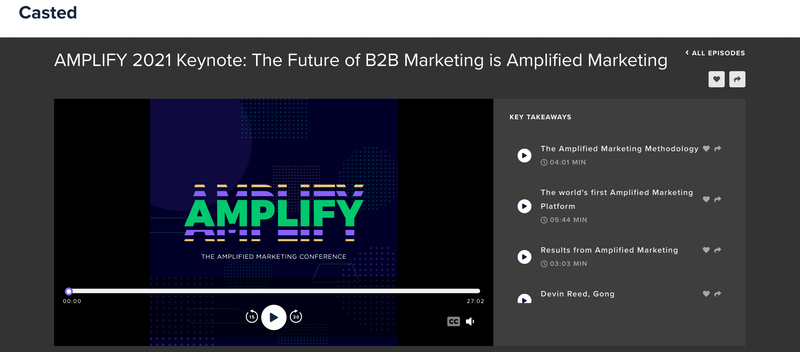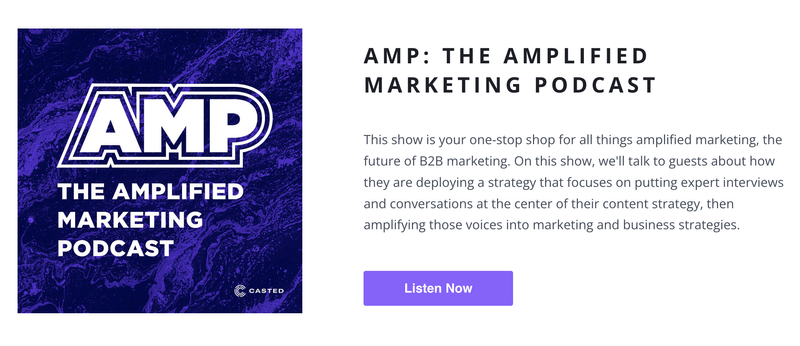Modern-Day Marketing: Working Smarter, Not Harder, to Amplify Events

Maximize Your Marketing ROI
Join 10,000 other marketers already getting the best tips on running engaging events that boost pipeline and create raving fans.
Calling all Event Marketers 👋 What happens after your events? Do you email registrants an on-demand link and move on to the next campaign? If so, we’ve got a totally new way of thinking for you.
Events are a treasure trove of content, and Modern Event Marketers know how to spin a single event into weeks or even months of content. With a little dedication and planning, you can transform your entire event strategy into a content flywheel that amplifies your message far and wide.
We were spoiled to be joined by not one but two rockstar marketers, Holly Pels, VP of Marketing at Casted, and Brett McGrath, VP of Marketing at The Juice for our event on all things content amplification.
We covered things like:
- How to think like a modern-day event marketer
- 10+ ideas on how to spin events into additional content
- Campaign examples from Casted and The Juice on successful content repurposing
We’ll share a few highlights below, but be sure to watch the full webinar for more inspiration on modern-day marketing and how to make the most of your events. 👇
What is “Modern-Day” Marketing, and how does it differ from what many of us know and practice?
Brett kicked things off with a heartfelt breakdown of modern-day marketing.
He remembered how he had had an epiphany while on a Zoom call with a marketer during his early days at The Juice. This marketer was very passionate and talked about the different things she was doing to reach her audience.
And that was the moment Brett realized who the modern-day marketer was. It is the individual who pushes against the status quo and is a catalyst for change in B2B marketing. This individual puts the audience first, and they value the experience of the people they are trying to reach.
For the modern-day marketer, things like content promotion and content distribution have changed dramatically. Five to ten years ago, it was like being a part of a content factory. We would create blog posts because we were trying to feed algorithms.
There was this continual cycle where you were not necessarily thinking about the content and making sure it resonated with your audience. With modern-day marketing, it's about taking your piece of content and thinking strategically about where the people you want to promote it to are hanging out.
So, you go into these communities, groups, and platforms, and you listen and learn. You try to address and answer questions from the community and share your content through that space.
Instead of taking content and saying, “we need to drive leads from this,” modern-day marketing is about taking a piece of content and creating connections and driving affinity. It’s about content distribution, and not so much about syndication.
What are some of the biggest mistakes or misconceptions you see about events or repurposing those events into additional content?
Holly had a few misconceptions to note about repurposing content.
For one, people often have events and they move on to the next thing. For example, they host a webinar, slap it up on their website, and move on to the next item on their list.
That is a symptom of a problem, which is the over-emphasis on quantity. Often, people don't look at events as what they are, which is really great conversations.
As marketers, we have gotten a lot smarter about what the audience actually wants. But one additional piece of that strategy to focus on is this—here is some of your best content, and it needs to be repurposed.
Often, people don't look at events as what they are, which is really great conversations.
For instance, this particular conversation can fuel “how-to” articles, or it could make an e-book or a report, all these different things that could help educate people.
One possible mistake in repurposing content is starting with your opinion. Remember, they are conversations with experts—so, it’s essential to start with the point of view of others. Your audience actually cares about their opinion. There is no better way to serve content to your audience. Often, people don't do it because it is hard.
It can be a missed opportunity to ignore how rich event content is. There is so much value in the conversations at these types of events. Repurposing their content is doable. And, it doesn't have to be expensive, as Holly pointed out.
You can use transcription tools and try different things that can help you take audio and video content and create something from them. It can be a really easy process that actually helps you fuel the rest of your content strategy.
What are your thoughts on quality versus quantity when it comes to content?
Both Holly and Brett had a lot to say when it comes to quality versus quantity—including a hot take from Holly.
According to Brett, we are stuck in this world of “more, more, more” as marketers. We always want to create more leads, more pipelines, and more sales opportunities—everyone wants more.
But, why does everything have to be volume-based? A question Brett asks himself often to make sure that he’s not playing the “more game” is, “Am I doing this for my metrics? Or am I doing this for my audience?”
There is an opportunity to rethink how we approach what we are doing and think about things from a quality perspective. Think about how you can build more quality connections that can lead to significant breakthroughs for your brand.
And we need to get away from the space of always reporting on the cookie-cutter metrics B2B SaaS uses to track a business’s success. Each business is different, audiences are different, and the people who buy the products are different.
You want to, of course, look at your metrics where you can, but not everything can be measured. At The Juice, Brett is working on and thinking about how to track and measure the non-traditional KPIs and things that happen in different moments to you as marketers.
Take for instance, someone responding to your email newsletter, talking about how awesome that idea was and how they are going to implement it at their place of business. That's not something that necessarily fits on a spreadsheet, but it could be a lot more powerful than some of the other things you are tracking.
Holly admitted that hers could be a controversial answer—it has to be both quality and quantity. As a content marketer, you have to find a balance. And most often, quality drives quantity.
If you start with a really good and solid piece of content, then you could turn it into lots of other things that could fuel a content flywheel. It’s easier because the content already exists.
Of course, you still have to produce a lot of different things. But if you really focus on quality first, instead of just getting all the things out, it can help you fuel more of the things you want to create.
What are some big events or campaigns that you’ve launched where you’ve used this approach and seen success?
Holly wrapped things up by sharing Casted’s approach to repurposing content from its Amplify event.
Amplify 2021 was slated as an in-person event, but with uncertainties arising once again because of the pandemic, the team decided to pivot back to a virtually-only experience. However, that didn’t stop Casted from pulling out all the stops to make Amplify a one-of-a-kind event.

The team hosted all sessions on Goldcast and used many of the engagement features like live chat and polls to interact directly with attendees.
After the live event, Casted quickly created and distributed the on-demand content for folks to peruse at their leisure after the event.
They also used Amplify to launch their new show, Amplified Marketing Podcast (AMP for short). The team was able to add custom intros to each session and transformed the live video version into podcast episodes. This audio-only approach was a brilliant way to give event sessions a much longer life than just the on-demand video content.

Of course, the team also used event snippets and key moments across email, social media, and more—the bread and butter of content repurposing.
Casted is just getting started with event content amplification. The team has several in-person events scheduled this year, and they’re already planning all of the different ways to recycle all of that great content across different formats and channels.
—
Thank you, Brett and Holly, for sharing your takes on content repurposing and the whole quality versus quantity debate. It was an enlightening conversation for all modern-day marketers out there!

Transform Your Video Marketing with AI
Stay In Touch
Platform
Resources
© 2025 Copyright Goldcast, Inc. All rights reserved.





 Upcoming Events
Upcoming Events Event Series
Event Series On-Demand Events
On-Demand Events

